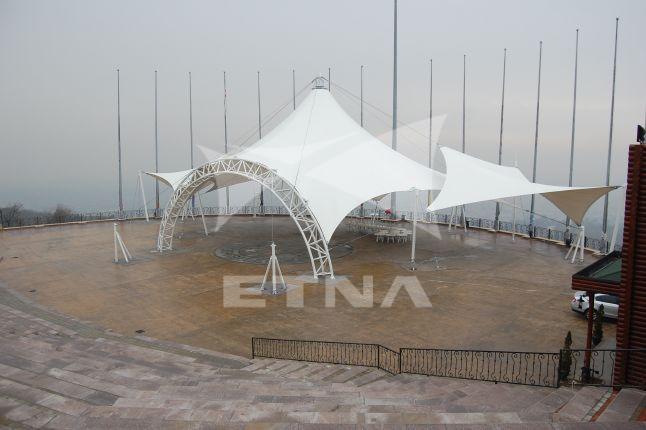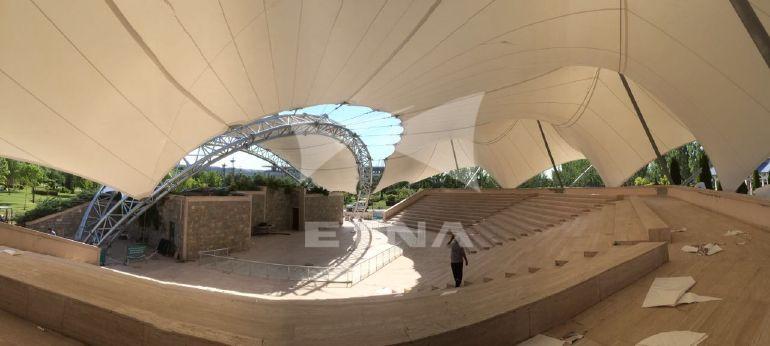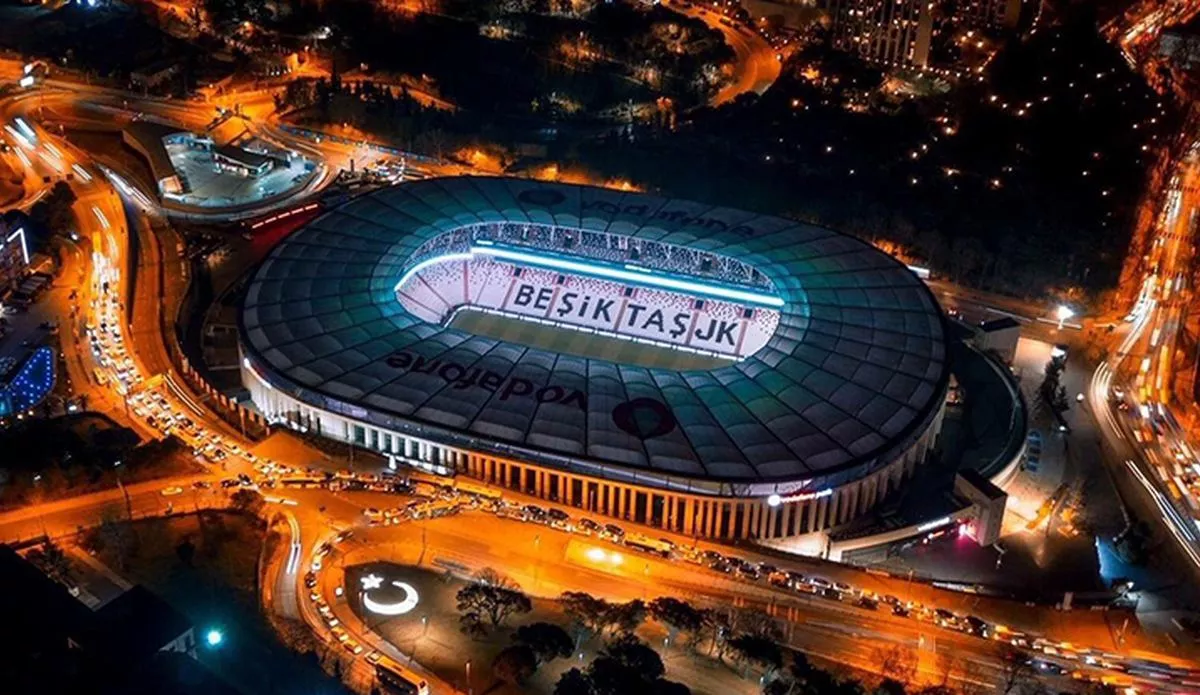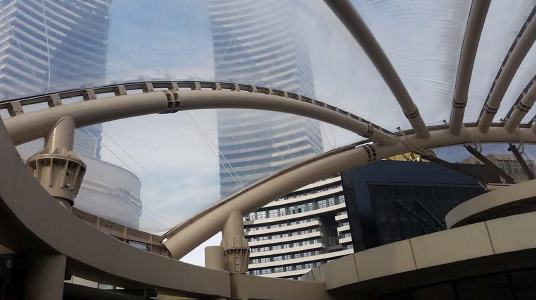
PVC/PTFE/ETFE Membrane Structures
PVC
PVC membrane is a cost-effective alternative to traditional roofing systems and can be produced in a multitude of colors to coordinate with individual building project needs. When produced in bright white, this flexible fabric membrane reduces radiant heat gain, keeping interior temperatures cooler during warmer weather conditions.
PVC membrane is commonly coated with a protective acrylic or PVDF top coat with a design life of approximately 15-20 years. If PVC membrane is exposed to high levels of UV in such areas like Florida or in the Southwest U.S., the design life of PVC is approximately 10-15 years.
Technically, PVC is a molecule comprised of carbon, hydrogen and chlorine. The combination of these elements results in a single-ply membrane that is simple to manufacture. During fabrication, remnants can be recycled and melted down to be reproduced, resulting in less waste.
Because PVC is a thermoplastic, this membrane can be softened into a semi-solid state and infused with UV light inhibitors and anti-soiling fungicides. During installation, multiple sheets of the fabric can be overlapped and fused together in a process known as weldable seam technology. Once cooled at room temperature, these sheets form one continuous membrane.
PVC coated with non-toxic and flame-resistant TiO2 (titanium dioxide) produces a photocatalytic membrane that functions like the leaves of a tree, providing shade and comfort while actively neutralizing airborne pollutants and odors. The unique self-cleaning benefits of TiO2 allow the material to break down dirt and other organic materials through a chemical reaction with the sun’s UV rays, oxygen and water vapor, present in the air.
This reaction, known as oxidation-reduction, converts these materials into harmless gases and natural components without using excess chemicals, solvents or water. The resulting sediments are simply washed away by rain. As a result, the membrane material remains bright and clean, reducing the need for frequent service.

PTFE
PTFE fiberglass membranes can be installed in climates ranging from the frigid arctic to the scorching desert heat with an expected project life exceeding 30 years.
PTFE fiberglass coating is chemically inert, capable of withstanding temperatures from -100°F to +450°F (-73°C to +232°C). The low-surface free energy of the material creates a surface which is readily cleaned by rainwater. It is also completely immune to UV degradation. PTFE-coated fiberglass membrane passes as non-combustible to ASTM E-136 / Class A (Incombustibility of Substrate). This unique combination of inertness, thermal stability and surface properties make Birdair’s PTFE-coated fabric membrane ideal for projects requiring superior weather and fire resistance. PTFE fiberglass structures have been constructed around the world with acceptance by British, French, Italian, Australian, Japanese and German National Standards, as well as guidelines set by the American Society for Testing and Materials (ASTM).
PTFE fiberglass is additionally Energy Star and Cool Roof Rating Council certified. During scientific tests of its solar properties, it was discovered that PTFE fiberglass membranes reflect as much as 73 percent of the sun’s energy while holding just seven percent on its exterior surface. Certain grades of PTFE fiberglass can absorb 14 percent of the sun’s energy while allowing 13 percent of natural daylight and seven percent of re-radiated energy (solar heat) to transmit through.
PTFE’s fiberglass yarns maintain ultimate tensile strength of 500,000 PSI and a modulus of elasticity of 10.5 x 106 PSI compared to steel, which offers 40,000 PSI and 29 x 106 PSI respectively. Under normal conditions, the fabric behaves elastically and does not undergo significant stress relaxation or creep.
The woven fiberglass gives the PTFE fiberglass membrane its mechanical strength. These filaments, known as beta glass, are the smallest diameter available and provide the membrane with maximum flexibility. The fibers are drawn from hot melt glass through platinum dies into continuous filaments, and are then twisted and plied into yarn bundles. The yarns are woven into a wide structural fabric, which is then coated with PTFE fiberglass to complete the process.
The principal element that differentiates PTFE fiberglass membrane from conventional glazing is its advantageous shading coefficient. As lighting levels increase, even cooler climates can realize overall energy savings using PTFE fiberglass membrane. In very warm climates, even low lighting levels make PTFE fiberglass membrane an energy saver versus conventional systems. The savings can be more dramatic when compared with conventional sloped glazing systems.

ETFE
ETFE (Ethylene Tetrafluoroethylene) film is durable, highly transparent and very lightweight in comparison to glass structures. ETFE is being considered the material of choice for traditional skylight applications to long span structures and building facades. Few building materials can match ETFE for its impact or presence when you want a structure that stands out from the crowd.
Single Layered Application
ETFE can be applied in a single layered form and are reinforced with either wire cables, light weight steel or aluminum to maintain shape and stability.
Double or Triple Layered Application
In a double or triple layered application, ETFE film incorporates a pneumatic system to maintain air between 2 or 3 layers of film attached in aluminum extrusions and supported by a lightweight structure creating inflated cushions. These cushions are filled with low-pressure air, providing thermal insulation and structural stability against wind or snow loads. If needed, small cables can be used for reinforcement. Under typical loading conditions, ETFE cushions can range from 5 to 15 feet wide and reach up to 200 feet in length.

Our PVC/PTFE/ETFE Material Suppliers
9 Great Reasons to Choose ETNA

Happy Customers

7/24 Technical Suppprt

Professional Team

Best Quality Material

Global Workforce

On-Time Delivery

Architectural Design/Engineering

PMP Project Management Professional



